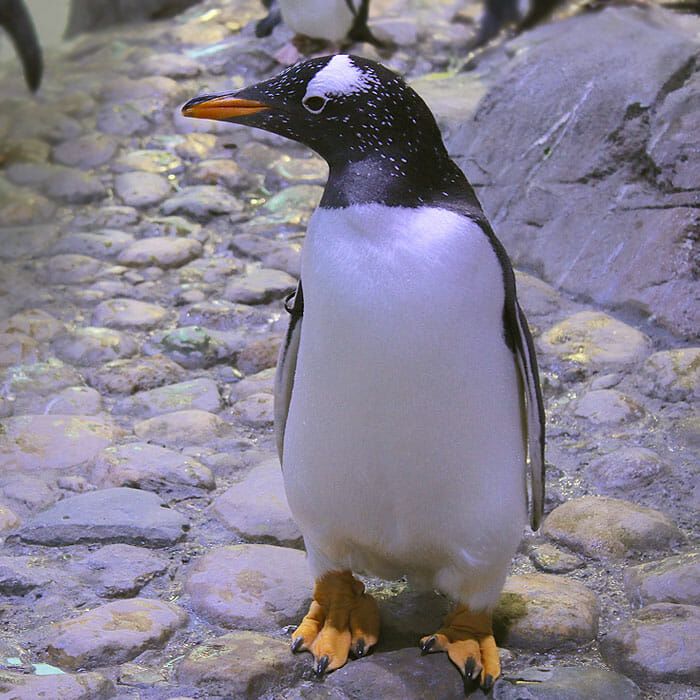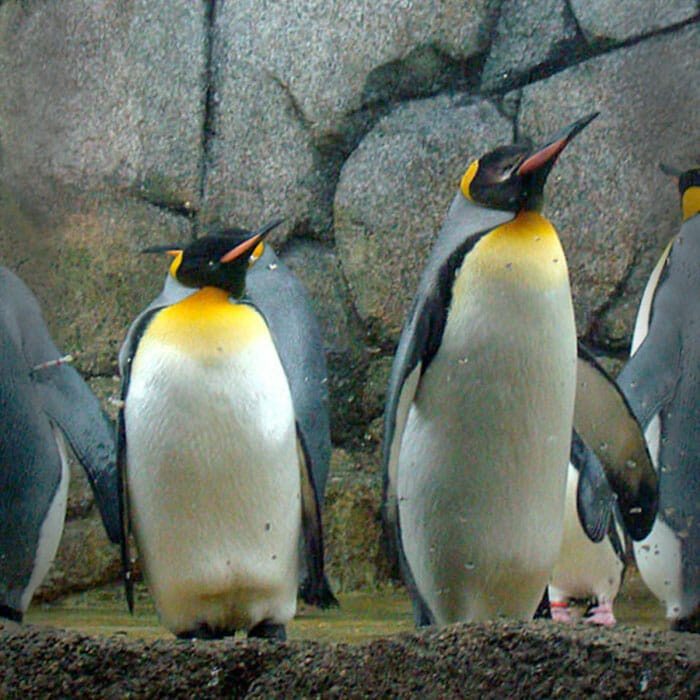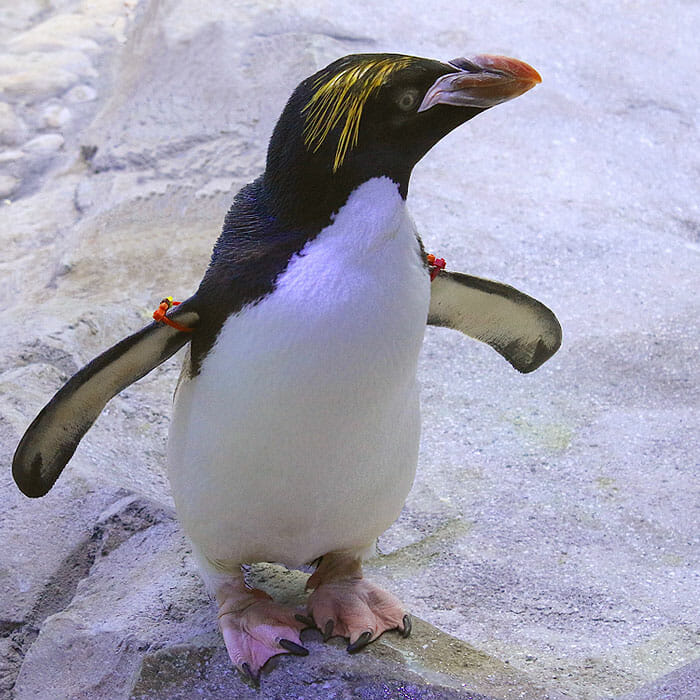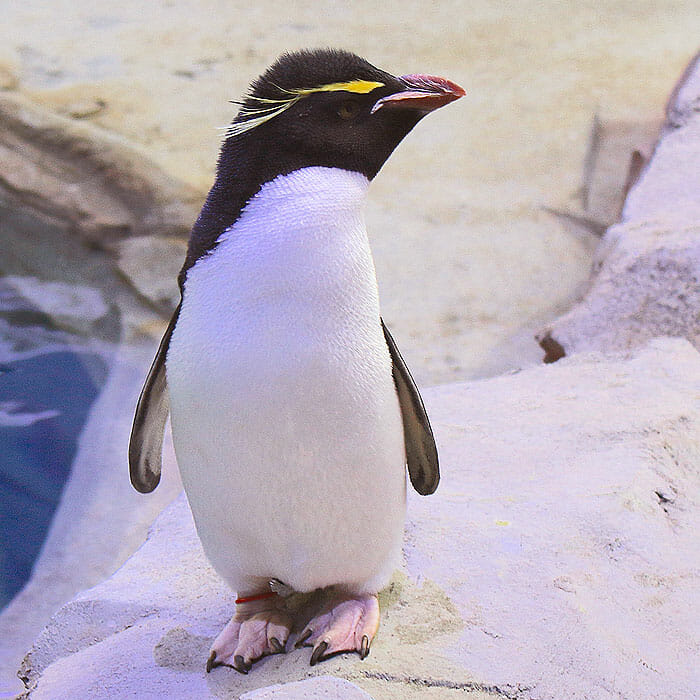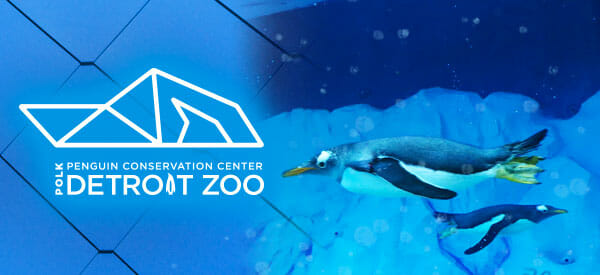The Polk Penguin Conservation Center is home to more than 80 penguins of four species.
Watch them waddle!
The live penguin cam from the Polk Penguin Conservation Center is available from 10 a.m. to 4 p.m. daily.
Gentoo Penguin (Pygoscelis papua)
The gentoo is recognized by the white stripe extending across its head and its bright red-orange bill. It has paddle-shaped, peach-colored feet and fine feathers that help it glide easily and quickly through the water. It is the third-largest penguin, after the king and emperor.
Gentoo Penguin (Pygoscelis papua)
The gentoo is recognized by the white stripe extending across its head and its bright red-orange bill. It has paddle-shaped, peach-colored feet and fine feathers that help it glide easily and quickly through the water. It is the third-largest penguin, after the king and emperor.
| Animal Facts: |
- Size: 20-24 inches tall
- Weight: 10-15 pounds
- Diet: Fish and krill (varies by location)
- Reproduction: During mating season, the female will lay two spherical, white eggs which both the male and female take turns incubating for over a month until the eggs hatch.
- Lifespan: 15-20 years (wild); 20-30 years (captivity)
- Conservation Status: Near Threatened
|
| Fun Fact: |
- The gentoo penguin can often be seen “flying” out of the water and landing on its feet.
|
King Penguin (Aptenodytes patagonicus)
Vivid orange feathers on the king’s head and upper chest distinguish it from other penguin species. It is the second-largest penguin, after the emperor.
King Penguin (Aptenodytes patagonicus)
Vivid orange feathers on the king’s head and upper chest distinguish it from other penguin species. It is the second-largest penguin, after the emperor.
| Animal Facts: |
- Size: 2-3 feet tall
- Weight: 20-30 pounds
- Diet: Mainly fish; some squid
- Reproduction: Males and females “dance” – they stand tall, trumpet and then bow to each other to start the courtship ritual. Once a mate has been selected, they breed for life. The male incubates the egg for approximately 54 days under a pouch of belly skin – called a brood pouch – that keeps it at the penguin’s internal body temperature.
- Lifespan: 15-20 years (wild); 20-30 years (captivity)
- Conservation Status: Least Concern
|
| Fun Facts: |
- The king penguin has a special gland that filters salt from the water.
- It can dive to great depths and its eyes are adapted to seeing underwater; a powerful lens results in shortsightedness on land.
|
Macaroni Penguin Eudyptes chrysolophus)
The scientific name for the macaroni penguin, Eudyptes chrysolophus, describes the distinguishing features of the bird. Eudyptes means “good diver” and chrysolophus means “with a golden crest”. It has distinct yellow and black plumes extending backward from its beak.
Macaroni Penguin Eudyptes chrysolophus)
The scientific name for the macaroni penguin, Eudyptes chrysolophus, describes the distinguishing features of the bird. Eudyptes means “good diver” and chrysolophus means “with a golden crest”. It has distinct yellow and black plumes extending backward from its beak.
| Animal Facts: |
- Size: About 2 feet tall
- Weight: Average of 11 pounds
- Diet: Mostly krill; sometimes fish
- Reproduction: Breeding season starts in October and November. The male incubates the egg for approximately 35 days with some help from the female. The male will brood the chick after hatching and during the guard stage for about three weeks.
- Lifespan: 15-20 years (wild); 20-30 years (captivity)
- Conservation Status: Vulnerable
|
| Fun Facts: |
- The macaroni’s plumes reminded early English explorers of an 18th century man called a “macaroni” who wore flashy feathers in his hat – thus the name.
- Its wings have evolved for use as flippers.
- It can hold its breath for up to three minutes.
|
Southern Rockhopper Penguin (Eudyptes chrysocome)
The rockhopper has black and white feathers, with yellow feathers extending from its eyebrows backwards. It is the smallest of the six species of crested penguins.
Southern Rockhopper Penguin (Eudyptes chrysocome)
The rockhopper has black and white feathers, with yellow feathers extending from its eyebrows backwards. It is the smallest of the six species of crested penguins.
| Animal Facts: |
- Size: 16-18 inches tall
- Weight: Average of 7 pounds
- Diet: A mix of fish, crustaceans and cephalopods
- Reproduction: The female and male share egg-incubation duties for 35 days. The male will brood the chick after hatching and during the guard stage for about three weeks.
- Lifespan: 15-20 years (wild); 20-30 years (captivity)
- Conservation Status: Vulnerable
|
| Fun Facts: |
- The name rockhopper comes from the bird’s ability to jump off cliffs. When on land, it tends to hop. It can jump up to 6 feet.
- The male can produce “penguin’s milk” for the hatchling if the female does not come back with food.
|
